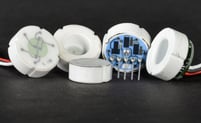 Ceramic pressure sensors by Metallux of Switzerland are high quality, high performing sensors for harsh environments and/or higher pressures (models up to 800 bar). With various models including piezo-resistive, ceramic capacitive, monolithic, flush-mount, compensated, unamplified and more, a user reviewing ceramic pressure sensors may want some help understanding the various options.
Ceramic pressure sensors by Metallux of Switzerland are high quality, high performing sensors for harsh environments and/or higher pressures (models up to 800 bar). With various models including piezo-resistive, ceramic capacitive, monolithic, flush-mount, compensated, unamplified and more, a user reviewing ceramic pressure sensors may want some help understanding the various options.

Piezo-Resistive Versus Capacitive: At a high level, Metallux ceramic pressure sensors are either piezo-resistive or capacitive pressure sensors. Why choose one over the other? Capacitive sensors are used when the pressure sensors must withstand high overpressures. In addition, capacitive models such as the ME550 (shown right) are very good at measuring low pressure down to 60 mbar. Both capacitive and piezo-resistive have similar chemical resistance and media compatibility.
 Flush Mount Versus Monolithic: In a flush mount sensor such as the ME77X Series, the sensor side exposed to the pressure media is flat and smooth. A monolithic sensor such as the ME75X has an indentation in the center of the exposed side. Why choose one or the other? If a customer is making an absolute or sealed gauge sensor, then flush mount is ideal as they have a fixed reference. Flush mount also come in lower (0.5 bar) and higher pressures (up to 600 bar). Flush mount ceramic sensors also have no dead volume of the pressure media.
Flush Mount Versus Monolithic: In a flush mount sensor such as the ME77X Series, the sensor side exposed to the pressure media is flat and smooth. A monolithic sensor such as the ME75X has an indentation in the center of the exposed side. Why choose one or the other? If a customer is making an absolute or sealed gauge sensor, then flush mount is ideal as they have a fixed reference. Flush mount also come in lower (0.5 bar) and higher pressures (up to 600 bar). Flush mount ceramic sensors also have no dead volume of the pressure media.
Amplified or Unamplified: Another choice in ceramic pressure sensors involves whether or not to choose an amplified, calibrated sensor (ME75X, ME78X, ME790) or an unamplified model (ME501, ME504, etc). The choice depends on the users' requirements. For customers who do not have the capacity to amplify the signal and wanted a completely calibrated and temperature compensated sensor, Metallux offers many models with either a ratiometric, non-ratiometric, current loop, or I2C. The integrated signal conditioning lets users start using the sensors quickly. A user who is perhaps designing their own transducer will likely consider purchasing an unamplified model. Then, these users who typically have the experienced needed, can create a customized signal conditioning design based on their specific application requirements.
Physical Size: Not all Metallux ceramic pressure sensors are the same size! The largest is the ME509 at 32.4 mm in diameter. The smallest is me ME657 at 12.85 mm in diameter. Many models are 18 mm in diameter.
Ceramic pressure sensors are a great choice if you are looking for higher pressures (up to 800 bar) in a harsh or wet environment. Gauge, sealed gauge and absolute models are also available. Strong chemical resistance due to the user of the AI2O3 ceramic lets users expose the sensors to a wide variety of environmental factors. Typical applications for Metallux ceramic pressure sensors include transducer development, tank level monitoring, process control and industrial automation.
We hope you found this blog post to be useful! Please feel free to reach out to us at info@servoflo.com with questions or comments. We welcome your feedback.
Download the metallux-family-tree here.


